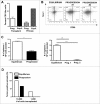Identification and editing of stem-like cells in methylcholanthrene-induced sarcomas
- PMID: 30546937
- PMCID: PMC6287773
- DOI: 10.1080/2162402X.2017.1404212
Identification and editing of stem-like cells in methylcholanthrene-induced sarcomas
Abstract
The cancer stem cell (CSC) paradigm posits that specific cells within a tumor, so-called CSC-like cells, have differing levels of tumorigenicity and chemoresistance. Original studies of CSCs identified them in human cancers and utilized mouse xenograft models to define the cancer initiating properties of these cells, thereby hampering the understanding of how immunity could affect CSCs. Indeed, few studies have characterized CSCs in the context of cancer immunoediting, and it is currently not clear how immunity could impact on the levels or stem-like behavior of CSCs. Using the well-studied 3'methylcholanthrene (MCA) model of primary sarcoma formation, we have defined a CSC-like population within MCA-induced sarcomas as expressing high levels of stem cell antigen-1 (Sca-1) and low levels of CD90. These Sca-1+CD90- CSC-like cells had higher tumor initiating ability, could spontaneously give rise to Sca-1-negative cells, and formed more sarcospheres than corresponding non-CSC-like cells. Moreover, when examining MCA-induced sarcomas that were in the equilibrium phase of cancer growth, higher levels of CSC-like cells were found compared to MCA-induced sarcomas in the escape phase of cancer progression. Notably, CSC-like cells also emerged during escape from anti-PD-1 or anti-CTLA4 therapy, thus suggesting that CSC-like cells could evade immune therapy. Finally, we demonstrate that paradoxically, interferon (IFN)-γ produced in vivo by immune cells could promote the emergence of CSC-like cells. Our findings define the existence of a Sca1+CD90- CSC-like population in the MCA-sarcoma model capable of differentiation, tumorsphere formation, and increased tumor initiation in vivo. These cells may also act as mediators of immune resistance during cancer immunoediting and immune therapy.
Keywords: MCA Sarcoma; cancer immune surveillance; cancer immunoediting; cancer stem cells; immune therapy.
Figures




Similar articles
-
Aldh1 Expression and Activity Increase During Tumor Evolution in Sarcoma Cancer Stem Cell Populations.Sci Rep. 2016 Jun 13;6:27878. doi: 10.1038/srep27878. Sci Rep. 2016. PMID: 27292183 Free PMC article.
-
Hepatoblastoma Cancer Stem Cells Express PD-L1, Reveal Plasticity and Can Emerge upon Chemotherapy.Cancers (Basel). 2022 Nov 25;14(23):5825. doi: 10.3390/cancers14235825. Cancers (Basel). 2022. PMID: 36497307 Free PMC article.
-
Cell biological profiling of reprogrammed cancer stem cell-like colon cancer cells maintained in culture.Cell Tissue Res. 2019 Mar;375(3):697-707. doi: 10.1007/s00441-018-2933-8. Epub 2018 Oct 3. Cell Tissue Res. 2019. PMID: 30284085
-
A critical analysis of the tumour immunosurveillance controversy for 3-MCA-induced sarcomas.Br J Cancer. 2009 Aug 4;101(3):381-6. doi: 10.1038/sj.bjc.6605198. Br J Cancer. 2009. PMID: 19638986 Free PMC article. Review.
-
Resistance to Cell Death and Its Modulation in Cancer Stem Cells.Crit Rev Oncog. 2016;21(3-4):203-219. doi: 10.1615/CritRevOncog.2016016976. Crit Rev Oncog. 2016. PMID: 27915972 Free PMC article. Review.
Cited by
-
Immune evasion by cancer stem cells.Regen Ther. 2021 Mar 11;17:20-33. doi: 10.1016/j.reth.2021.02.006. eCollection 2021 Jun. Regen Ther. 2021. PMID: 33778133 Free PMC article. Review.
-
Targeting Cancer Stem Cells through Epigenetic Modulation of Interferon Response.J Pers Med. 2022 Apr 1;12(4):556. doi: 10.3390/jpm12040556. J Pers Med. 2022. PMID: 35455671 Free PMC article. Review.
-
Emerging trends in immunotherapy for pediatric sarcomas.J Hematol Oncol. 2019 Jul 16;12(1):78. doi: 10.1186/s13045-019-0756-z. J Hematol Oncol. 2019. PMID: 31311607 Free PMC article. Review.
References
Publication types
LinkOut - more resources
Full Text Sources
Research Materials
